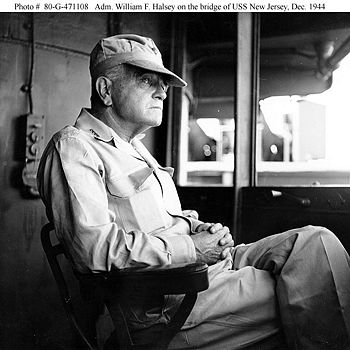William Halsey
William F. "Bull" Halsey (1882-1959) was a fleet admiral of the U.S. Navy, a colorful and inspirational combat leader in the Second World War. He was also quite controversial in terms of his ability at the level of fleet command, especially at the Battle of Leyte Gulf. One of his most authoritative biographers, E. B. Potter, had begun his work tending to believe that argument, but eventually saw him as
a man not without shortcomings but with qualities of leadership, courage, judgment, good will and compassion that utterly outweigh his faults.[1]
As Halsey points out in his autobiography, "Bull" was the nickname of the press corps, not the Navy. Named for his father, he was first called "Old Bill", then "Bill" in the Navy, and "more recently I suppose it is inevitable for my juniors to think of me, a fleet admiral and five times a grandfather, as "Old Bill" Now that I am sitting down to my autobiography, it is Bill Halsey whom I want to get on paper, not the fake, flamboyant "Bull.""[2] It is a Navy legend, however, that an officer, entering Halsey's darkened command information center during a battle, muttered "is that old goat here?" and received a thunderous response, "Who are you calling old?
Early life and career
Born into a Navy family, he graduated from the United States Naval Academy in 1904, specializing in torpedo warfare. "He commanded the First Group of the Atlantic Fleet's Torpedo Flotilla in 1912-13 and several torpedo boats and destroyers during the 'teens and 'twenties. Lieutenant Commander Halsey's First World War service, including command of USS Shaw (Destroyer # 68) in 1918, was sufficiently distinctive to earn a Navy Cross."
In 1922-25, Halsey served as Naval Attache in Berlin, Germany and commanded USS Dale (DD-290) during a European cruise. [3]
Senior command
After Pacific commander Chester W. Nimitz concluded that VADM Robert Ghormley had become dispirited and exhausted, Halsey was sent to replace his old friend, and revive the command.
Carl Solberg, an intelligence officer on Halsey's staff, wrote that Halsey was kept ashore at Noumea, after his early task force leadership, to provide motivation for demoralized U.S. forces in the South Pacific. Once they began to operate independently, the new system of fleet command was instituted.[4]
Fleet Admiral
Halsey was the last Navy officer promoted to the special rank of Fleet Admiral. Four such promotions were authorized for the Navy, although William Leahy was arguably a White House rather than Navy officer.
Halsey's peer, Raymond Spruance, as or more highly respected in the Navy than Halsey, was blocked for the promotion by Congressional politics.
Postwar
References
- ↑ E. B. Potter (1985), Bull Halsey, U.S. Naval Institute, ISBN 0870211463, p. xiii
- ↑ William F. Halsey and J. Bryan III (1947), Admiral Halsey's Story, McGraw-Hill, p. 1
- ↑ Fleet Admiral William F. Halsey, Jr., USN, (1882-1959), Navy Heritage and Historical Command (formerly Naval Historical Center)
- ↑ Carl Solberg (1995), Decision and dissent: with Halsey at Leyte Gulf, U.S. Naval Institute, ISBN 1557509710, pp. 14-15

